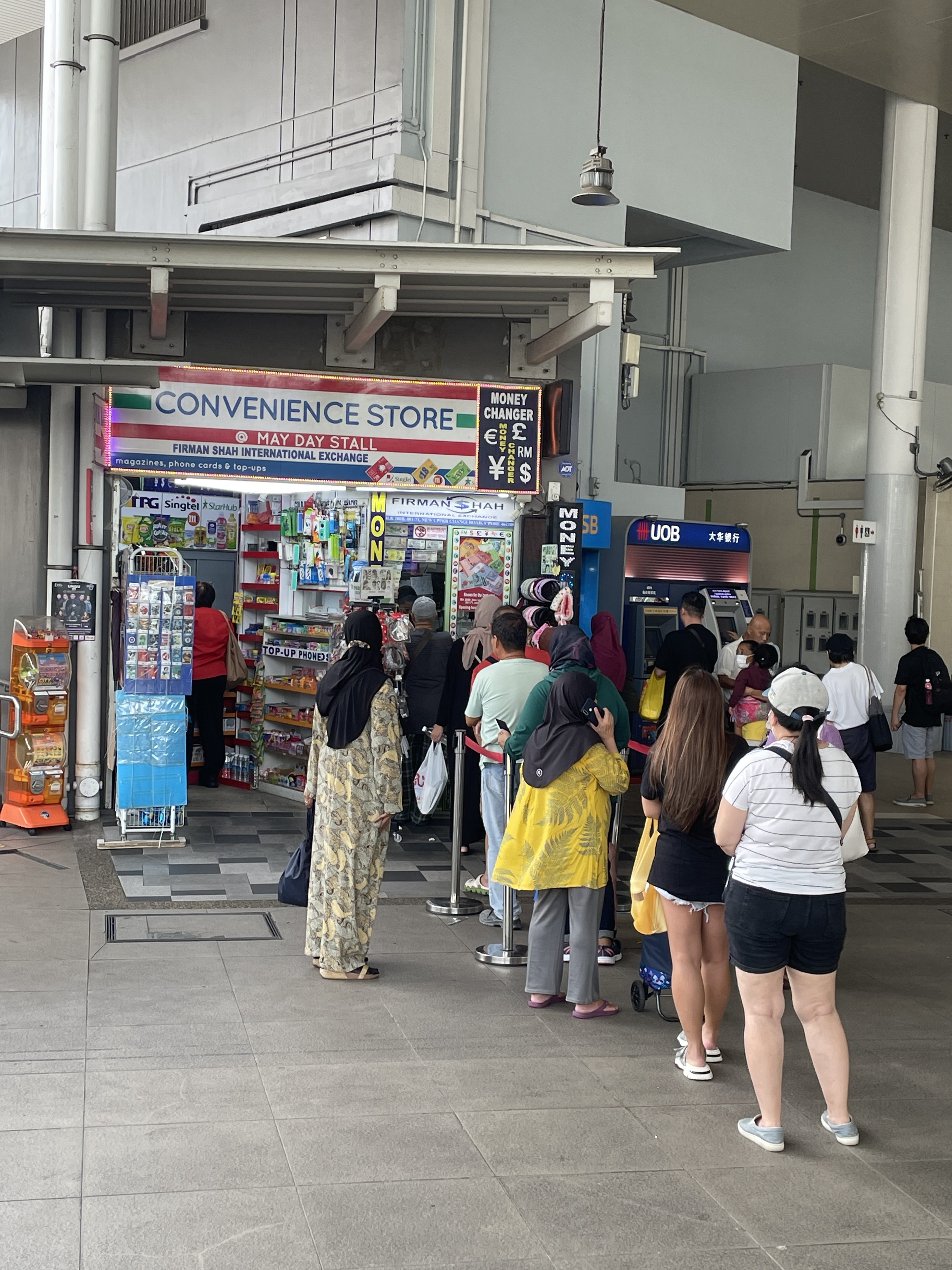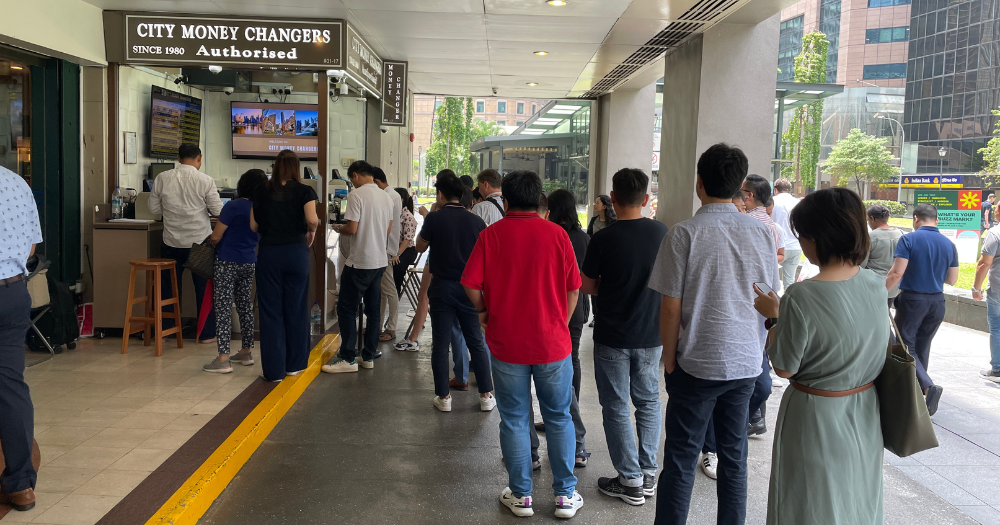 There's probably never been a better time to buy Malaysian Ringgit, after the Singapore dollar reached a record high of S$1 to RM3.50 last Tuesday (Oct. 24).
There's probably never been a better time to buy Malaysian Ringgit, after the Singapore dollar reached a record high of S$1 to RM3.50 last Tuesday (Oct. 24).
While you might expect a mad rush of people joining queues at money changers in Singapore, or planning impromptu trips to Malaysia, the reality is not quite as extreme.
A visit to moneychangers located at the Arcade at Raffles Place and Bedok Interchange showed that few were queuing up to change money on impulse, even though a fair number saw the recent exchange rate as good news.
Long queues at money changers, many buying Ringgit
Mothership observed a steady stream of customers at the Arcade's moneychangers over lunch time on a Friday (Oct. 27).
This included curious onlookers craning their necks to scrutinise the latest rates.
 Long queues were spotted outside moneychangers located at the Arcade, near Raffles Place. Image by Daniel Seow.
Long queues were spotted outside moneychangers located at the Arcade, near Raffles Place. Image by Daniel Seow.
 There was a steady stream of customers at the Arcade's moneychangers around lunch time. Image by Daniel Seow.
There was a steady stream of customers at the Arcade's moneychangers around lunch time. Image by Daniel Seow.
There was clearly a bustling business in the Malaysian currency, evidenced by the amounts of Ringgit we saw change hands.
Rates varied from about 3.446 up to 3.45, which was the highest we saw advertised.
Two of the shops we visited also indicated that Ringgit was temporarily out of stock.
Moneychangers at Bedok Interchange, on the other hand, attracted a far smaller crowd. Only one prominent shop located at the Bedok Interchange hawker centre had some semblance of a queue.
 Customers queuing at Firman Shah International Exchange, one of the few moneychangers at Bedok who had queues on Oct. 27 afternoon. Image by Daniel Seow.
Customers queuing at Firman Shah International Exchange, one of the few moneychangers at Bedok who had queues on Oct. 27 afternoon. Image by Daniel Seow.
Rates we saw were similar to the ones we saw at the Arcade.
Customers in Bedok could exchange S$1 for RM3.45, if they exchanged S$300 or more.
That said, customers in the queue told Mothership that the same shop had long queues in the evening, earlier in the week after the 3.50 rate was announced.
How much are customers changing?
Fardin, 50, who has relatives across the border and visits two to three times a month, said that he changed about S$1,000 worth of Ringgit. Some of it was spare cash to keep for future trips.
"My relatives, my friends, they are all changing [Ringgit], and some are slowly succumbing," he said, adding that he found the current rates attractive.
Another Malaysian customer in his 50s agreed that the current exchange rate definitely made it tempting to add to his personal stash of Ringgit.
He changed S$1,000 to S$2,000 so that he would have extra Ringgit to spend on groceries and enjoy a day in Johor Bahru next week.
Apart from Malaysians or those with relatives there, Singaporeans who were more excited about the current Ringgit rates seemed to be those who already had plans to travel there.
Jean (not her real name), a Singaporean in her 20s, saw it as a good time to get some extra cash, since she was already going for a trip to Kuala Lumpur in December.
Since she already had some Ringgit at home, she opted to change S$250 for what she felt was a competitive rate of 3.45.
She added that her friends were "all coming down to change Ringgit too".
Difference from previous rates might be negligible
Not everyone in the queue was changing Ringgit, however.
A good number of customers we spoke to were there for other currencies, such as the Thai baht, Taiwan dollar or Japanese yen.
One of these was June Chong, 45, who was buying Taiwanese currency.
Chong pointed out that when she bought Ringgit a few months back, the official rate was 3.47.
"RM3 is only S$1...[so] it's not much difference", Chong added.
Chong was not tempted to jump on the bandwagon now as she thinks the trend will carry on, and the Ringgit will weaken further.
She believes the government will keep the Singapore dollar strong against foreign currencies.
While she does go to Malaysia once every few months, she prefers to change only "when she needs to".
Chong felt that those who would be the most thrilled by the current rates would be Malaysians who work here.
Business is slightly better: Money changer
A money changer Mothership spoke to shared that the current Ringgit rates have led to a small uptick in business.
Nasar, 37, who operates Green Point Money Exchange in Bedok with his father, said that the current rates are good for business as customers tend to change more.
 Nasar, a moneychanger in Bedok, said business was slightly better with the record high Ringgit exchange rate. Image by Daniel Seow.
Nasar, a moneychanger in Bedok, said business was slightly better with the record high Ringgit exchange rate. Image by Daniel Seow.
However, when asked if the queues were longer than usual, Nasar admitted the difference wasn't noticeable.
He pointed out that Ringgit is in constant demand regardless of the rates.
"Even though the rate goes down or goes up, still people will change money because everyday, people travel to Malaysia...to purchase things, [or for] holidays, business," he explained.
In fact, since post-pandemic travel resumed, he has seen increased demand for a wide range of currencies, including the US dollar, European and Asian countries, and attributes the longer queues to the fact that "people love to travel".
As for whether he has run out of stock for Ringgit, Nasar said he hasn't.
Will the exchange rate get even better?
So are we likely to get a much better rate than S$1 to RM3.5 anytime soon?
Short answer: likely not.
In response to Mothership's query, Christopher Wong, FX Strategist at OCBC Bank, pointed out that the record high achieved last week was due to the underperformance of the Ringgit.
This was due to reasons such as weakening sentiments in China, higher US Treasury yields, the current geopolitical tensions between Israel and Hamas, and the slump in Malaysian exports.
Wong said that two recent developments will lead to the Ringgit catching up with the Singapore dollar.
The first being that the US Treasury yields have eased slightly.
The second has to do with China’s announcement to raise fiscal deficit ratio to 3.8 per cent and issue one trillion RMB sovereign bonds to support the economy — and also bodes well for the Ringgit.
If these developments continue till the end of 2023, Wong expects the Ringgit will stand a better chance of recovering against the Sing dollar.
Philip Wee, Senior FX Strategist at DBS Bank, added that the Singapore dollar has persistently strengthened against the Ringgit, and especially so after US interest rates were hiked up in March 2022.
This aligns with the Monetary Authority of Singapore's policy initiated in October 2021 to appreciate the Singapore dollar to counteract inflation.
Wee also pointed out that the Ringgit's recovery depends on whether the US Federal Reserve follows through with their interest rate hike to curb inflation, as outlined in September projections.
If so, he estimates that in the worst case scenario, the exchange rate between Singapore dollar and Ringgit might escalate to S$1 to RM3.55.
But in the best case scenario for the Ringgit, the rate might retract to as low as 3.4050, if the US regains control on inflation and Asia's export cycle transitions from recession to recovery.
So now you know.
Related articles:
Top image by Daniel Seow.

If you like what you read, follow us on Facebook, Instagram, Twitter and Telegram to get the latest updates.


